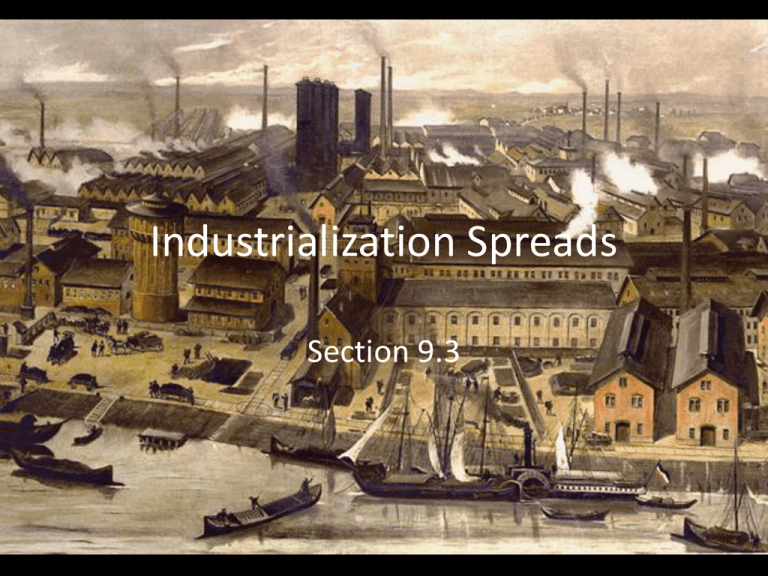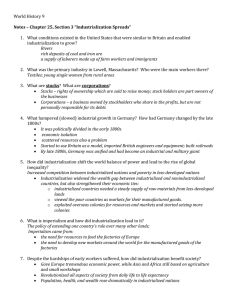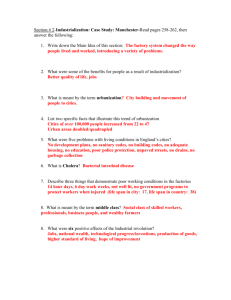Spread of the Industrial Revolution
advertisement

Industrialization Spreads Section 9.3 England • First country to industrialize on huge scale • Inspired other countries to industrialize – Copy the “British miracle” • Class structure becomes more rigid • Raises the world standing of England – Crystal Palace – built to show the wealth and power of English industrialization America • Has a wealth of resources similar to Britain – War of 1812 – Britain blockades America • Forces US to rely on own resources to develop industry • Industrialization started with textiles – England had forbid engineers, mechanics, and toolmakers from leaving country - protect secrets – Samuel Slater emigrates to America • Brings the design of the spinning machine • Moses Brown used it to start first mechanized factory – Francis Cabot Lowell revolutionized American textiles by mechanizing all stages in cloth manufacturing • Became model for American factories America • Social changes – Mill girls: Women moving to factory towns • Higher wages • Independence • Watched closely by factory owners to ensure “proper behavior” – Cities grow similar to Britain –Immigrants • Usually take unskilled jobs • Came looking for opportunity and usually ended up in factories • Many were Northern European • Discrimination America: Later Expansion • Northeast saw the majority of the industrialism – Industrial boom after Civil War • South rebuilt • New inventions: – Better excavation of natural resources – Electric light bulb, telephone • Rise of railroads – Chicago and Minneapolis huge centers – Railroads became profitable • Symbols of power • End of the 1800s – small number of companies control 2/3rds of the tracks America: Rise of Corporations • Need money to build large businesses – Stock – certain rights of ownership in the company – Corporation – business owned by stockholders who share in profits but are not responsible for debts • Protects people who invest • Corporations – Standard Oil (John D. Rockefeller) – Carnegie Steel Company (Andrew Carnegie) – Horizontal Integration – Control every aspect of industry in order to make big profits • Wealthy earned money, workers were still given low wages Belgium • First continental country to industrialize • William Cockerill, illegally traveled to Belgium – Plans for spinning machinery – Son, John, built industrial enterprise in Belgium • Produced mechanical equipment – Steam engines – Railway locomotives • Never became a European industrial power - Congo Germany • Pockets of industrialization – Coal-rich valley of the Ruhr • 1835, kingdoms in German Confederacy copied British model – Imported British machines – Wealthy sent children to England to learn industrial management • Built railroads linking manufacturing cities – Frankfurt to the Ruhr Valley • Industrialization allowed Prussia to create Germany and make it industrial powerhouse by late 1800s Continental Europe: Everywhere else • Industrialization: – Catalonia (Spain) - cotton – Bohemia - spinning – Northern Italy – machine made silk – France - most stable • Agriculture did not suffer as people moved to cities • 1850s – create railroads to connect the country • Some places never industrialized: – Austria-Hungary – mountainous land = no railroads – Ottoman Empire – difficult to control large empire – Spain – lacked good roads and waterways • Fragmented control of country Impact of Industrialization: Imperialism • Industrialized countries needed natural resources, gained by seizing other countries – Imperialism – policy of extending one country’s rule over other lands – Gave more power to these industrializing powers Impact of Industrialization: Society • Western countries: – Economies focused on industry – Wealth gaps between classes • Resentment allowed for revolutionary ideas – Increase of middle class allowed for more education – not majority – Improved life expectancy as industrialization moves along • Eastern countries: – Economies focused on agriculture, small workshops – Decreased power and wealth – Eastern peoples were “lesser” because not industrialized Impact of Industrialization: Nationalism • Countries compare themselves, which strengthens differences – Industrial power is indicator of strength of nationalism and country









